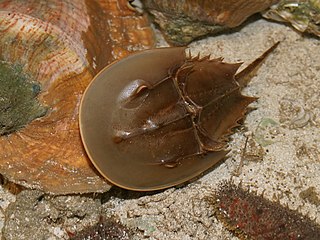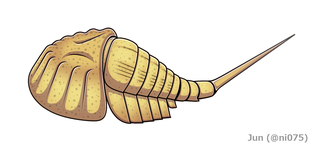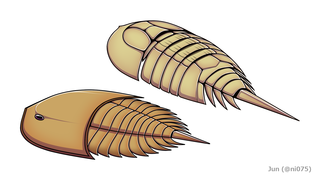
The subphylum Chelicerata constitutes one of the major subdivisions of the phylum Arthropoda. It contains the sea spiders, arachnids, and several extinct lineages, such as the eurypterids and chasmataspidids.

Arachnida is a class of joint-legged invertebrate animals (arthropods), in the subphylum Chelicerata. Arachnida includes orders containing spiders, scorpions, ticks, mites, harvestmen, and solifuges. In 2019, a molecular phylogenetic study also placed horseshoe crabs in Arachnida.

The Atlantic horseshoe crab, also known as the American horseshoe crab, is a species of marine and brackish chelicerate arthropod. Despite their name, horseshoe crabs are more closely related to spiders, ticks, and scorpions than to crabs. It is found in the Gulf of Mexico and along the Atlantic coast of North America. The main area of annual migration is Delaware Bay along the South Jersey Delaware Bayshore.

Horseshoe crabs are marine and brackish water arthropods of the family Limulidae, suborder Xiphosurida, and order Xiphosura. Their popular name is a misnomer, as they are not true crabs, nor even crustaceans, as crabs are, but a different order of arthropod.

Chasmataspidids, sometime referred to as chasmataspids, are a group of extinct chelicerate arthropods that form the order Chasmataspidida. Chasmataspidids are probably related to horseshoe crabs (Xiphosura) and/or sea scorpions (Eurypterida), with more recent studies suggest that they form a clade (Dekatriata) with Eurypterida and Arachnida. Chasmataspidids are known sporadically in the fossil record through to the mid-Devonian, with possible evidence suggesting that they were also present during the late Cambrian. Chasmataspidids are most easily recognised by having an opisthosoma divided into a wide forepart (preabdomen) and a narrow hindpart (postabdomen) each comprising 4 and 9 segments respectively. There is some debate about whether they form a natural group.

Willwerathia is a genus of synziphosurine, a paraphyletic group of horseshoe crab-like fossil chelicerate arthropods. Willwerathia known only by one species, Willwerathia laticeps, discovered in deposits of the Devonian period from the Rhenish Slate Mountains of Germany.

Bembicosoma is a genus of synziphosurine, a paraphyletic group of fossil chelicerate arthropods. Bembicosoma was regarded as part of the clade Planaterga. Fossils of the single and type species, B. pomphicus, have been discovered in deposits of the Silurian period in the Pentland Hills, Scotland. Bembicosoma had been tentatively assigned as an eurypterid before its synziphosurine affinities revealed.
Bunaia is a genus of synziphosurine, a paraphyletic group of fossil chelicerate arthropods. Bunaia was tentatively placed as part of the clade Planaterga. The genus contains at least one species: Bunaia woodwardi from the Silurian period in Svalbard, Norway. Only a few morphological information of B. woodwardi had been confirmed, as the species known only from poorly preserved specimens compose of semicircular carapace, fragments of opisthosoma and disarticulated telson. The placement of "Bunaia" heintzi within this genus had been questioned and required further investigation.

Bunodes is a genus of synziphosurine, a paraphyletic group of fossil chelicerate arthropods. Bunodes was regarded as part of the clade Planaterga. Fossils of the single and type species, B. lunula, have been discovered in deposits of the Silurian period in Ludlow, England. Bunodes is the type genus of the family Bunodidae, the other genera of the same family being Limuloides.

Cyamocephalus is a genus of synziphosurine, a paraphyletic group of fossil chelicerate arthropods. Cyamocephalus was regarded as part of the clade Planaterga. Fossils of the single and type species, C. loganensis, have been discovered in deposits of the Silurian period in Lesmahagow, Scotland. Cyamocephalus is one of the two members of the family Pseudoniscidae, the other being Pseudoniscus. Cyamocephalus differ from Pseudoniscus by the fused tergites of 6th and 7th opisthosomal segments.

Legrandella is a genus of synziphosurine, a paraphyletic group of fossil chelicerate arthropods. Legrandella was regarded as part of the clade Prosomapoda. Fossils of the single and type species, L. lombardii, have been discovered in deposits of the Devonian period in Cochabamba, Bolivia.

Limuloides is a genus of synziphosurine, a paraphyletic group of fossil chelicerate arthropods. Limuloides was regarded as part of the clade Planaterga. Fossils of the genus have been discovered in deposits of the Silurian period in the United Kingdom and potentially in the United States. Limuloides is one of the two genera of the family Bunodidae, the other being the type genus Bunodes. Limuloides is characterized by a carapace with radiated ridges and serrated lateral regions, and an opisthosoma with rows of nodes. Limuloides was once though to have lateral compound eyes on its carapace, but later investigation did not find any evidence of it.

Pasternakevia is a genus of synziphosurine, a paraphyletic group of fossil chelicerate arthropods. Pasternakevia was regarded as part of the clade Planaterga. Fossils of the single and type species, P. podolica, have been discovered in deposits of the Silurian period in Podolia, Ukraine.

Pseudoniscus is a genus of synziphosurine, a paraphyletic group of fossil chelicerate arthropods. Pseudoniscus was regarded as part of the clade Planaterga. Fossils of the genus have been discovered in deposits of the Silurian period in the United Kingdom, the United States and Estonia. Pseudoniscus is one of the two members of the family Pseudoniscidae, the other being Cyamocephalus.

Weinbergina is a genus of synziphosurine, a paraphyletic group of fossil chelicerate arthropods. Fossils of the single and type species, W. opitzi, have been discovered in deposits of the Devonian period in the Hunsrück Slate, Germany.

Synziphosurina is a paraphyletic group of chelicerate arthropods previously thought to be basal horseshoe crabs (Xiphosura). It was later identified as a grade compose of various basal euchelicerates, eventually excluded form the monophyletic Xiphosura sensu stricto and only regarded as horseshoe crabs under a broader sense. Synziphosurines survived at least since early Ordovician to early Carboniferous in ages, with most species are known from the in-between Silurian strata.

Pseudoniscidae is an extinct family of synziphosurine chelicerates that lived in the Silurian. Pseudoniscidae is classified inside the clade Planaterga, alongside Bunodidae and Dekatriata. Pseudoniscidae is composed by two genera, Cyamocephalus and Pseudoniscus.

Venustulus is a genus of synziphosurine, a paraphyletic group of fossil chelicerate arthropods. Venustulus was regarded as part of the clade Prosomapoda. Fossils of the single and type species, V. waukeshaensis, have been discovered in deposits of the Silurian period in Wisconsin, in the United States. Venustulus is one of the few synziphosurine genera with fossil showing evidence of appendages.

Camanchia is a genus of synziphosurine, a paraphyletic group of fossil chelicerate arthropods. Camanchia was regarded as part of the clade Prosomapoda. Fossils of the single and type species, C. grovensis, have been discovered in deposits of the Silurian period in Iowa, in the United States. Alongside Venustulus, Camanchia is one of the only Silurian synziphosurine with fossil showing evidence of appendages.

Anderella is a genus of synziphosurine, a paraphyletic group of fossil chelicerate arthropods. Anderella was regarded as part of the clade Prosomapoda. Fossils of the single and type species, A. parva, have been discovered in deposits of the Carboniferous period in Montana, in the United States. Anderella is the first and so far the only Carboniferous synziphosurine being described, making it the youngest member of synziphosurines. Anderella is also one of the few synziphosurine genera with fossil showing evidence of appendages, but the details are obscure due to their poor preservation.



















